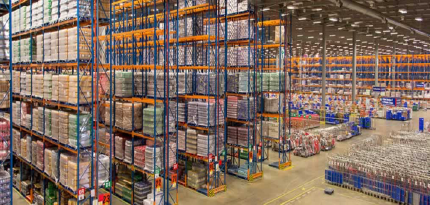Trasnational Open Training
“Influencing trends in European logistics planning”
Webinar edition, 15th and 22nd May 2017
SULPiTER Organised a set of webinar on trends which are influencing the city logistics planning in Functional Urban Areas.
The trainings are organized by the project SULPiTER (Sustainable Urban Logistics PlannIng To Enhance Regional freight transport) with the aim to improve the Sustainable Urban Logistics Plans (SULPs) in Functional Urban Areas.
Webinar 1
Changing production & consumption

The first webinar, dedicated to the categories Changing production & consumption and Spatial organisation was held on the 15th May 2017.
Consumption can be defined in different ways, but is best described as the final purchase of goods and services by individuals. In the last ten years we have seen major developments in economic growth, globalization and opening of new markets that have changed how and what we consume. As we become wealthier, we consume more. We have also changed culturally and socially. 'Individualisation’, the belief in the individual and the desire for ownership and personal freedom, means that by consuming, we can express ourselves through the goods and services we choose and can enjoy the feeling of personal freedom through, for example, our cars and plane travel.
Production is defined as a process of combining various material and immaterial inputs (raw materials, know-how) in order to make something for consumption (the output). It is the act of creating output, a goods or services that have value and contributes to the utility of individuals. Production is driven by consumers’ needs and expectations, which demands more and more personalized products to be delivered at customers’ addresses. Consumer driven concept is leading towards pull logistics strategy and calling for responsive production with highly optimized and rationalized processes.
Goods deliveries for professional and private customers generate an important flow of vehicles, from small vans (for express deliveries) to trucks (to supply the largest stores). Delivery services are increasing due to just-in-time management, e-commerce development and the emergence of new customer behaviours (home delivery, drive and delivery lockers).
Literature
- What is Consumption in Economics.
- Population and Consumption.
- Production (economics).
- Patier, David , Chalon, Deslandres (2014): A New Concept for Urban Logistics Delivery Area Booking.
Spatial Organization

Regions are commonly organized along an interdependent set of cities forming what is often referred as an urban system. The key spatial foundation of an urban system is based on a series of market areas, which are a function of the level of activity of each centre in relation with the friction of distance. The spatial structure of most regions can be subdivided in three basic components (J.P. Rodrigue, 2016):
- A set of locations of specialized industries (such as manufacturing), which tend to group into agglomerations according to location factors such as raw materials, labour, markets, etc. They are often export-oriented industries from which a region derives the bulk of its basic growth.
- A set of service industry locations, including administration, finance, retail, wholesale and other similar services, which tend to agglomerate in a system of central places (cities) providing optimal accessibility to labour or potential customers.
- A pattern of transport nodes and links, such as road, railways, ports and airports, which services major centres of economic activity.
Jointly, these components define the spatial order of a region, mostly its organization in a hierarchy of relationships involving flows of people, freight and information. More or less well defined urban systems spatially translate such development. Many conceptual models have been proposed to explain the relationships between transport, urban systems and regional development, the core-periphery stages of development and the network expansion being among those.
Spatial organisation of transport and logistics in FUAs is influenced by geographical situation as well as by distribution of resources and population. The fragmentation of production and consumption, the locational specificities of resources, labour and markets generate a wide array of flows of people, goods and information. The structure of these flows in terms of origin, destination and routing is closely related to spatial organization. Space shapes transport as much as transport shapes space. (adapted from J.P. Rodrigue, 2016)
The freight industry (Aljohani&Thompson, 2016) appears to have contradicting issues in urban areas, as it is required to operate efficiently and sustainably and adjust to the increasing urban freight activities. This has to be achieved with the majority of customers and retailers being located in inner urban areas while logistics facilities have been forced to relocate to the periphery of metropolitan areas. Inner urban areas still constitute a major retail and freight destination and attract/generate significant levels of freight movements with very limited supply of available and affordable commercial and industrial land to establish and operate logistics facilities.
The majority of Central European freight has its origin and destination within the Functional Urban Areas (FUAs). Road transport is still the prevailing mode of moving freight over short distances (average distance of national freight transport trips in 85 kms), with its major problem of poorly utilized vehicles and empty running (EAA, 2015). These problems has to be solved on the regional level and are to be tackled by the public authorities.
Literature
- dr. Jean-Paul Rodrigue: The Geography Of Transport Systems - Transport and Spatial Organization
- Aljohani, K., Thompson, R.G., Impacts of logistics sprawl on the urban environment and logistics: Taxonomy and review of literature, Journal of Transport Geography (2016)
- EEA 2015, Load factors for freight transport.
Training material related to the Webinar 1
- Recording of the session is available on Youtube here
- Presentations in PDF is available here.
- Complete literature and references for webinar 1 here
Webinar 2
The second part was held on May 22nd, 2017 and it was dedicated to the other two categories: Supply Chain management & Distribution and Technologies and equipment
Supply Chain management
Supply chain encompass the following three functions:
- Supply of materials to a manufacturer;
- the manufacturing process; and,
- The distribution of finished goods through a network of distributors and retailers to a final customer.
Complexity of supply chain requires efficient planning and management of all activities involved in sourcing, procurement, warehousing and transportation. In essence, supply chain management (SCM) integrates supply and demand management within and across companies. The primary objective of SCM is to fulfill customer demands through the most efficient use of resources, including distribution capacity, inventory, and labor. In theory, a supply chain seeks to match demand with supply and do so with the minimal inventory. Various aspects of optimizing the supply chain include liaising with suppliers to eliminate bottlenecks; sourcing strategically to strike a balance between lowest material cost and transportation, implementing just-in-time techniques to optimize manufacturing flow; maintaining the right mix and location of factories and warehouses to serve customer markets; and using location allocation, vehicle routing analysis, dynamic programming, and traditional logistics optimization to maximize the efficiency of distribution.
Supply chain management theories and methods mentioned above are seldom used when planning and evaluating urban logistics. This is leading to fragmentation of urban freight flows, unutilized freight vehicles, empty running and is consequently considerably contributing to traffic congestion, noise, low air quality and large commercial road traffic in the cities. •Logistics providers are still perceived as the one responsible for all those negative effects without understanding the role of customer that orders the delivery. Possibilities of vertical and horizontal collaboration are still not exploited.
Technologies and equipment
Innovations in technology are changing how the world does business, and technology is dramatically changing how entities in the logistics industry function in nearly every aspect. From increased affordability and efficiency of the transportation management system (TMS) to the application of Bluetooth technology for superior tracking of product movements and to the new wehicles concepts and new propulsion systems (Robinson, 2016). The use of electric vehicles (EVs) has been recognized as an efficient and promising strategy for urban freight and also successfully implemented for deliveries from the urban micro-consolidate center to customers. On the other side, the use of natural gas vehicles (NGVs) is still lagging behind, mainly due to restrictions caused by legal regulations on service stations, imperfect information and failure to coordinate complementary markets (Rosenstiel et al., 2016). Regardless the used propulsion technology of vehicle for urban freight transport, vehicles can be used more efficiently with the application of advanced information and communication technologies (ICT). The logistics industry has already embraced a wide range of information and communication technologies and reaped environmental benefits through reduced travel distances, fewer vehicle movements, better matching of vehicles to work and improved levels of load consolidation. Application of ICT in freight transport enables transport users to identify the services most suited to their purposes, and logistics operators to strategically manage freight shipments and deliveries (EC, 2015). Alongside the implementation of new vehicle propulsion, ICT and ITS, also several technologies to support automated road vehicles were developed, and some are operating in real-life applications (Parent, 2007). For example, dozens of driverless trucks are being used to haul materials in an iron-ore mine in Australia (Winston, 2014). On the other side, safety, reliability and robustness remain major issues for these new systems. Several legal and regulatory frameworks are presenting the limitation for wider implementation.
Lastly, not to be neglected, is also the user’s and societal acceptance of automated technologies which many times encounter on lack of trust and security, privacy concerns etc.. Although several research has been made in the field of automated system and vehicles in recent years, additional efforts will be necessary for regulation and social acceptance of such technologies.
Literature
- Robinson Adam, Logistics Technology Trends, 2016.
- von Rosenstiel, D. P., Heuermann, D. F., & Hüsig, S. (2015). Why has the introduction of natural gas vehicles failed in Germany?—Lessons on the role of market failure in markets for alternative fuel vehicles. Energy Policy, 78, 91–101.
- EC. 2015. Smart and sustainable logistics for a competitive Europe. Bulgaria
- Parent, M.2007. Advanced Urban Transport: Automation is on the way. IEEE Computer Society.
- Winston, C..2014. Improving Urban Mobility Through Technological Advance of Motor Vehicles.
Training material
- Recording of the session is available here,
- Presentations are available here.
- Complete literature and references for webinar 2 here
For more information on this event, contact Ms. Eleonora Tu:
e-mail: eleonora.tu@regione.emilia-romagna.it ph: +39 (0) 51 527 3246